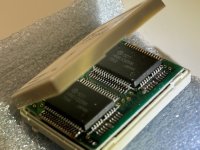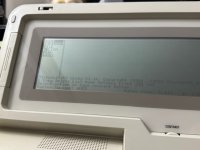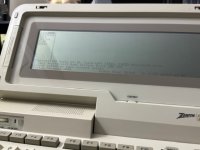One of my first computers back in the day was a Tandy 200, and a few years later, I replaced it with a Tandy 600. Why not, right? More contiguous memory, a floppy drive and it had an 80 character screen. Unfortunately, it was not quite the 'upgrade' that I was looking for and although I modified the screen to use an EL backlight, it never really became an adequate replacement, so I ended up selling it off, along with other items.
Fast forward a long time, but still a few years back and I am collecting Tandy and Panasonic laptops, (I still won't go near a Tandy 600), but some of the research that I did led me to a cousin of the 600, the Zenith ZP-150. After looking for one of these elusive items for over a decade, I finally found one and purchased it a couple months back. Oddly enough, another one of these showed up on eBay in mid December, along with the packing box and some, but not all of the associated items (I didn't buy it).
When I first got my Heath-Zenith ZP-150, I looked for all the online references that I could find and aside from a couple of period magazine reviews and a Heathkit catalog, a few sparse computer list descriptions, the YouTube demo from Russia and the side-by-side comparison to a Tandy 600, there is not a lot out there. (The Tandy 600 Facebook group mentions it, but there is no additional information that I found) So there was very little in the way of actual support material available out there. When I received mine, it had a screen that showed garbage on startup, which is similar to a condition found in the Tandy 600s and I did not know if it was related to the fact that someone had previously tried to open one of the ROM cartridges, or whether it was just that it needed to be 'cleared' or 'reset' in some way. I opened the computer and removed the backup battery and checked the motherboard to make sure there was no battery or capacitor issues and there did not appear to be any, so I closed it back up.
When the other ZP-150 came up for sale in December, they listed a picture of the front cover of the user uanual and I was able to determine from that, that another eBay auction that I had been watching had a copy of the ZP-150 user manual (along with some other Heath Zenith items), so I bought it. The User manual describes a cold startup procedure that is used when the machine is first purchased and also if it has been stored without energy (batteries installed) for longer than a couple weeks. Although it is a different procedure from the Tandy 600 key combination reset, it seems to accomplish the same thing and was exactly what I was looking for. In addition, to the user manual picture, there was also picture of the original AC adapter that showed the Volts, Amps and pin out, so I now know that I can use the same one that works for a Tandy 1100/Panasonic CP-150.
So, tonight, with all power off, I removed and opened the ROM cartridge to check for issues and seeing none (I also took pictures), I sealed and replaced it in the slot and then set the dip switch 8 to 'off' (all other switches to 'on'). Then, after a few minutes, I switched 8 to 'on' and 7 to 'off', then inserted the 9.5V power adapter and pressed the start button. It booted to the main menu and works perfectly.



Now onto the tough questions - whether to recap it or not, how to come up with more memory?
(it looks like there are at least a couple already there that I could use as a guide in making new pieces, similar to the ones that have been produced for T200 and T600s)
And the big ask - has anyone seen the ZP-150 Reference Manual for this? - it is supposed to be 900 pages according to a PC Magazine article that I found
Fast forward a long time, but still a few years back and I am collecting Tandy and Panasonic laptops, (I still won't go near a Tandy 600), but some of the research that I did led me to a cousin of the 600, the Zenith ZP-150. After looking for one of these elusive items for over a decade, I finally found one and purchased it a couple months back. Oddly enough, another one of these showed up on eBay in mid December, along with the packing box and some, but not all of the associated items (I didn't buy it).
When I first got my Heath-Zenith ZP-150, I looked for all the online references that I could find and aside from a couple of period magazine reviews and a Heathkit catalog, a few sparse computer list descriptions, the YouTube demo from Russia and the side-by-side comparison to a Tandy 600, there is not a lot out there. (The Tandy 600 Facebook group mentions it, but there is no additional information that I found) So there was very little in the way of actual support material available out there. When I received mine, it had a screen that showed garbage on startup, which is similar to a condition found in the Tandy 600s and I did not know if it was related to the fact that someone had previously tried to open one of the ROM cartridges, or whether it was just that it needed to be 'cleared' or 'reset' in some way. I opened the computer and removed the backup battery and checked the motherboard to make sure there was no battery or capacitor issues and there did not appear to be any, so I closed it back up.
When the other ZP-150 came up for sale in December, they listed a picture of the front cover of the user uanual and I was able to determine from that, that another eBay auction that I had been watching had a copy of the ZP-150 user manual (along with some other Heath Zenith items), so I bought it. The User manual describes a cold startup procedure that is used when the machine is first purchased and also if it has been stored without energy (batteries installed) for longer than a couple weeks. Although it is a different procedure from the Tandy 600 key combination reset, it seems to accomplish the same thing and was exactly what I was looking for. In addition, to the user manual picture, there was also picture of the original AC adapter that showed the Volts, Amps and pin out, so I now know that I can use the same one that works for a Tandy 1100/Panasonic CP-150.
So, tonight, with all power off, I removed and opened the ROM cartridge to check for issues and seeing none (I also took pictures), I sealed and replaced it in the slot and then set the dip switch 8 to 'off' (all other switches to 'on'). Then, after a few minutes, I switched 8 to 'on' and 7 to 'off', then inserted the 9.5V power adapter and pressed the start button. It booted to the main menu and works perfectly.



Now onto the tough questions - whether to recap it or not, how to come up with more memory?
(it looks like there are at least a couple already there that I could use as a guide in making new pieces, similar to the ones that have been produced for T200 and T600s)
And the big ask - has anyone seen the ZP-150 Reference Manual for this? - it is supposed to be 900 pages according to a PC Magazine article that I found
